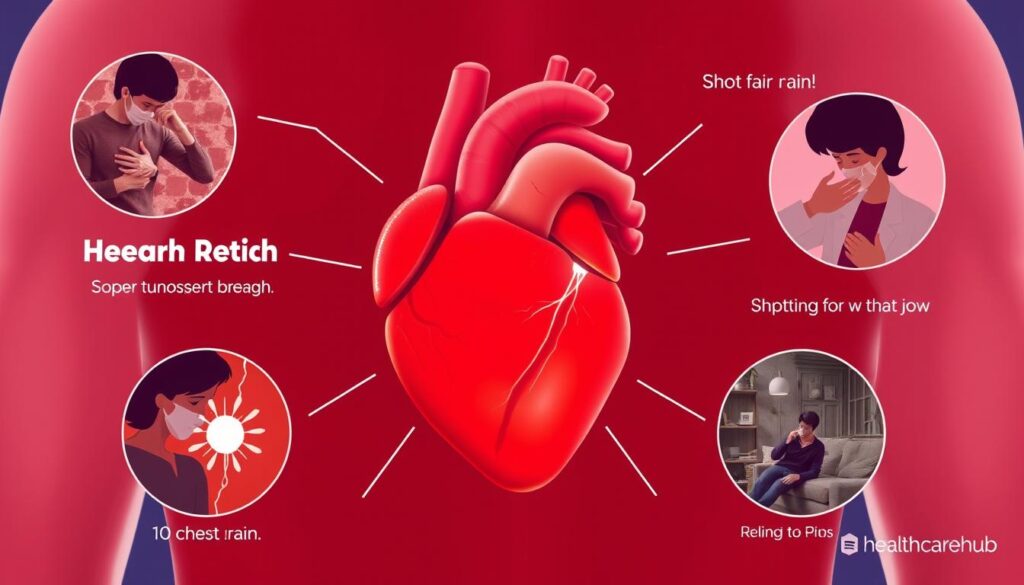Heart disease is a lifelong condition and the leading cause of death in the United States. It happens when arteries harden and narrow due to plaque buildup. A heart attack occurs when plaque bursts, causing a clot that blocks blood flow.
Managing heart disease involves lifestyle changes, medication, and sometimes medical procedures. Every 33 seconds, someone in the U.S. dies from cardiovascular disease. This adds up to nearly 700,000 deaths each year. But, heart disease is mostly preventable with healthy habits and proper care.
Key Takeaways
- Heart disease is a lifelong condition that requires continuous management and lifestyle changes.
- Lifestyle factors like diet, exercise, and weight management play a crucial role in preventing and managing heart disease.
- Regular medical screenings and prompt emergency response during a heart attack can significantly improve outcomes.
- Cardiac rehabilitation programs provide valuable support for those with heart disease or recovering from a heart attack.
- Controlling risk factors such as high blood pressure, high cholesterol, and diabetes is essential for heart health.
Understanding Heart Disease: Causes and Risk Factors
Heart disease is caused by many factors. These can be things we can’t control and things we can. Uncontrollable factors include age, gender, and family history. Controllable factors are lifestyle choices and medical conditions.
Common Types of Heart Disease
In the U.S., coronary artery disease (CAD) is the most common heart disease. It happens when plaque builds up in heart arteries. This can cause chest pain, shortness of breath, and even heart attacks.
Other heart diseases include heart valve problems, irregular heart rhythms, and heart failure.
Key Risk Factors to Monitor
- High blood pressure is a big risk for heart disease.
- High levels of LDL (bad) cholesterol can lead to plaque buildup.
- Diabetes raises the risk of heart disease death.
- Being overweight can lead to bad cholesterol and triglycerides.
- Tobacco use harms the heart and blood vessels.
- Drinking too much alcohol can also be harmful.
Family History and Genetic Factors
Genetics play a big role in heart disease. If a family member got heart disease young, you might be at higher risk. It’s important to get regular check-ups and manage risk factors well.
Knowing about heart disease risk factors and types helps prevent it. Working with doctors is key to managing heart disease.
Essential Medical Tests and Screenings for Heart Health
Regular health screenings are key for heart care and health. These tests help spot heart risks early. They guide treatments to keep your heart strong.
Key Screenings for Heart Health
- Blood pressure checks (starting at age 18, annually for those 40 and older or with risk factors)
- Cholesterol screenings (starting between ages 9-11, then every 1-2 years for adults)
- Type 2 diabetes screening (starting at 45 or earlier with risk factors)
More tests might include:
- Electrocardiograms (ECG) to check heart function and rhythm
- Stress tests to see how the heart works during activity
- Imaging studies like echocardiograms, CT scans, and MRIs to see the heart’s structure and blood flow
These tests help find heart risks early. They help doctors make the best treatment plans for your heart health. Regular check-ups are key for managing heart care and avoiding future problems.
| Screening Test | Recommended Frequency | Optimal Range |
|---|---|---|
| Blood Pressure | Annually for those 40+ or with risk factors | Less than 120/80 mm Hg |
| Cholesterol | Every 1-2 years for adults | Total Cholesterol: Less than 200 mg/dL LDL: Less than 130 mg/dL HDL: 50 mg/dL or higher |
| Blood Glucose | Every 3 years for those 45+ or with risk factors | Fasting: Less than 100 mg/dL |
| Body Mass Index (BMI) | Annually | 18.5 to 24.9 (normal weight) |
By being proactive with these tests, you can manage your heart health. Work with your doctors to prevent and manage heart risks.
Heart Disease Management: Prevention and Treatment Strategies
Managing heart disease needs a mix of lifestyle changes, sticking to medication, and medical help when needed. Knowing these strategies helps people protect their heart and avoid future problems.
Medication Management and Adherence
Medicines are key in managing heart disease. They include statins for cholesterol, blood pressure meds, and clot preventers. It’s vital to take your medicines as directed for your heart’s health. Talk to your doctor to understand your meds and how to use them right.
Medical Procedures and Interventions
At times, medical procedures are needed for heart disease. Angioplasty, stents, or bypass surgery can help. Cardiac rehab offers support with exercise, education, and counseling to help recovery and prevent future heart issues.
Working with Healthcare Providers
Talking regularly with your healthcare team is key for managing heart disease. Be involved in your care, discuss treatment plans, and share any concerns. Working together with your healthcare team ensures you get the best care for your heart.
By taking a holistic approach to heart disease management, you can control your heart health. Stick to your meds, get medical help when needed, and work closely with your healthcare team. This way, you can improve your heart health and lower the risk of future problems.
Creating a Heart-Healthy Diet Plan
Keeping a heart-healthy diet is key to avoiding and managing heart disease. A good diet includes colorful fruits and veggies, whole grains, lean proteins, and healthy fats. These changes can lower blood pressure, cholesterol, and heart disease risk.
The DASH and Mediterranean diets are great for heart health. They focus on plant-based foods like fruits, veggies, legumes, and whole grains. They also limit salt, added sugars, processed foods, and saturated fats.
- Fill half your plate with colorful fruits and veggies.
- Choose whole grains like brown rice, whole wheat bread, and oats.
- Go for lean proteins like poultry, fish, and legumes.
- Add healthy fats from olive oil, nuts, and avocados.
- Reduce salt, added sugars, and processed foods.
- Drink less alcohol and avoid smoking or vaping for heart health.
By following these dietary guidelines and making lifestyle changes, you can lower heart disease risk. This improves your overall health and well-being.
| Nutrient | Day 1 Menu | Day 2 Menu |
|---|---|---|
| Total Calories | 1,688 | 1,621 |
| Total Fat | 46g | 31g |
| Total Carbohydrates | 242g | 246g |
| Protein | 94g | 83g |
| Dietary Fiber | 29g | 24g |
| Added Sugar | 6g | 30g |
| Total Sugar | 147g | 118g |
| Sodium | 1,162mg | 1,558mg |
| Cholesterol | 126mg | 131mg |
| Calcium | 1,718mg | 1,591mg |
Following a heart-healthy diet and making lifestyle modifications is crucial. It helps manage cardiovascular risk factors and supports heart health.

“Eating a diet rich in fruits, vegetables, whole grains, and lean proteins can help reduce the risk of heart disease and stroke.”
Exercise and Physical Activity Guidelines for Heart Patients
Regular physical activity is key for heart health, even for those with heart conditions. By following safe exercise guidelines and creating a good routine, heart patients can boost their well-being. They can also better manage their heart condition.
Safe Exercise Recommendations
Before starting an exercise program, heart disease patients should talk to their doctor. This is especially true for those who have had a heart attack, chest pain, diabetes, or heart surgery. Aerobic activities like brisk walking, swimming, or light jogging are recommended 3 to 4 times a week. They help manage blood pressure, cholesterol, and blood sugar.
Resistance weight training can improve strength and daily activities. But, it’s not as good for the heart as aerobic exercise. It’s important to watch for heart symptoms during exercise. Signs include dizziness, chest pain, irregular heartbeat, shortness of breath, and nausea. Always carry nitroglycerin pills and track your pulse rates.
Building an Exercise Routine
Adults with heart disease should aim for 150 minutes of moderate-intensity aerobic activity or 75 minutes of vigorous aerobic activity weekly. They should also do muscle-strengthening activities 2 days a week. Start slowly and gradually increase the workout’s intensity and duration.
Monitoring Physical Activity
Make sure to take breaks and stay hydrated during strenuous activities. If you experience chest pain or changes in angina, contact your doctor. Regularly talking to your healthcare provider helps create a safe and effective exercise plan tailored to your needs.
“Regular physical activity can significantly improve the overall well-being and management of heart conditions for patients.”
Recognizing Heart Attack Warning Signs and Emergency Response
Knowing the signs of a heart attack can save lives. Chest pain or discomfort is a common sign. But, pain in the arms, back, neck, jaw, or stomach can also mean trouble.
Shortness of breath, nausea, and cold sweats are other warning signs. If you see these symptoms, call 9-1-1 right away. Quick action is key because treatments work best in the first hour.
Make a survival plan to be ready for a heart attack. Include emergency contacts and a list of your medicines. This info is vital in an emergency.
Key Heart Attack Risk Factors
- Age: Men 45 and older, women 55 and older, are at higher risk.
- High blood pressure, especially when combined with obesity, high cholesterol, or diabetes.
- High levels of low-density lipoprotein (LDL) cholesterol and triglycerides.
- Metabolic syndrome, which doubles the likelihood of developing heart disease.
- Family history of early heart attacks (before age 55 for males, 65 for females).
- Lack of physical activity and exercise.
- Stress, particularly extreme anger, and illegal drug use.
- Autoimmune conditions like rheumatoid arthritis or lupus.
Knowing these risk factors and managing them can lower your heart attack risk.

| Statistic | Value |
|---|---|
| People who turn to the American Red Cross annually for lifesaving skills training | More than 4.6 million |
| Percentage of fatal heart attacks that occur within the first two hours of symptom onset | Most people who succumb to fatal heart attacks |
| Difference between heart attacks and cardiac arrest | Heart attack is a blockage in blood vessels, cardiac arrest is when the heart stops beating effectively |
Spotting heart attack signs early and acting fast can save lives. Knowing the risks and having a survival plan can help you survive a heart attack.
Cardiac Rehabilitation and Recovery Process
Cardiac rehabilitation is key for heart disease patients. It includes exercise, education on heart health, and stress management. This helps patients get more active, adopt healthy habits, and manage risks better.
Studies show cardiac rehab greatly improves outcomes for those with heart issues. Working with a team of doctors, nurses, and pharmacists, patients create a plan tailored to their needs. This plan helps them improve their heart health.
The length of cardiac rehab varies, usually from 2 to 8 months. On average, it lasts about 3 months. This approach can lower the risk of death by about 35% in 5 years after a heart event. By focusing on cardiac rehab, patients can actively work towards a healthier life.















Randi Dittrick
Thank you for breaking down complex concepts so clearly. This blogpost answered a lot of questions I had. This post is really informative and provides great insights! This blog stands out among others in this niche. Great read! Looking forward to more posts like this.